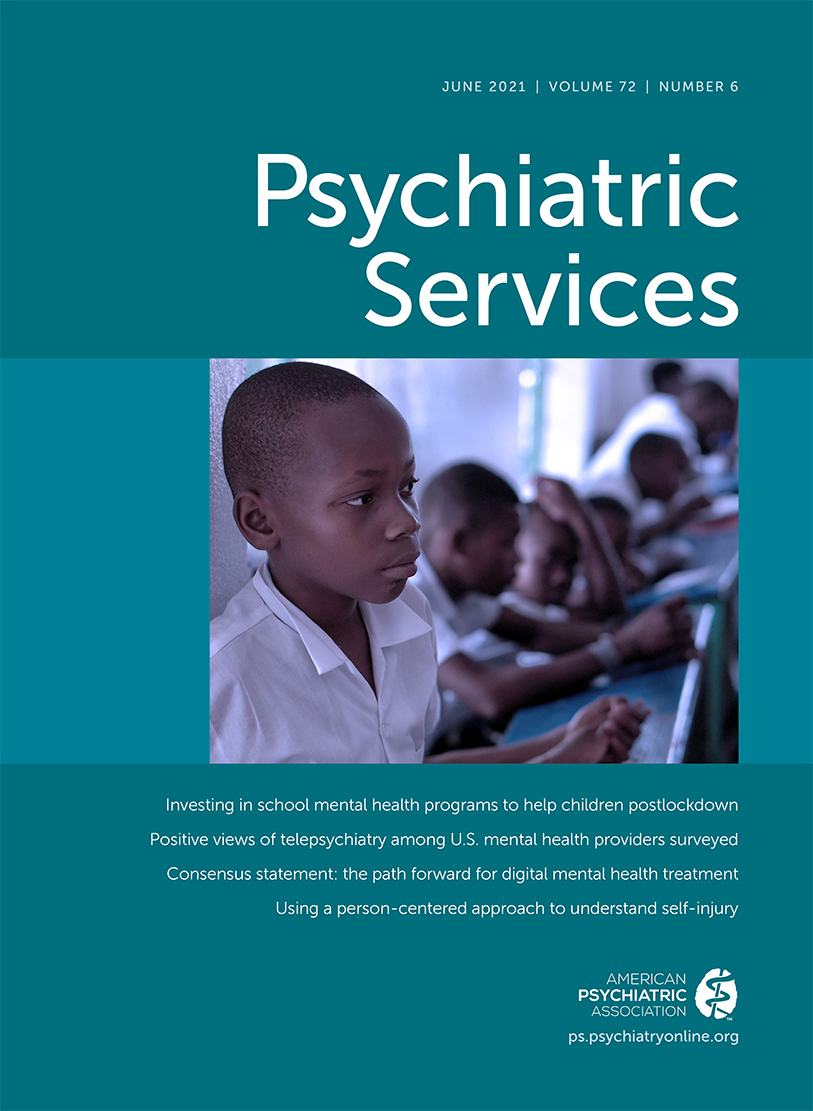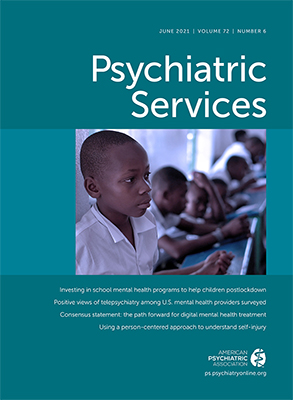Over the past several years, growing research and clinical attention has been paid to nonsuicidal self-injury (NSSI), the deliberate damaging of one’s body tissue for nonlethal reasons. Self-injury is a common and highly concerning mental health difficulty listed in the
DSM-5 as a condition warranting further consideration (
1). A review of extant literature indicates that approximately 18% of adolescents (ages 10–17 years) and 13% of emerging adults (ages 18–24 years) have self-injured; the rate is approximately 20% among university students (
2). Among children, rates are about 8% among preadolescents, ages 8–12 years (
1). Among adults (over 25 years of age), about 5%−6% report past self-injury (
1,
2). Because self-injury is most often used to obtain relief from painful emotion, it should come as little surprise that self-injury is a transdiagnostic behavior associated with a range of mental health diagnoses (e.g., major depression, eating disorders), although self-injury is not always associated with mental illness (
1). Furthermore, many individuals report scarring, which may contribute to shame and adversely affect recovery (
3). Of grave concern is a growing line of inquiry indicating that self-injury is the single most reliable predictor of subsequent suicide ideation and attempts (
1). Although some individuals engage in self-injury without suicidal intent, people who have self-injured are up to 5.5 times more likely than those who have not self-injured to attempt suicide (
4). Therefore, self-injury needs to be taken seriously and be appropriately addressed.
Despite frequently seeing individuals who self-injure, mental health professionals report a lack of knowledge about self-injury (
5). We direct this Open Forum to health care workers who serve as the initial point of contact for and play an important role in appropriately triaging and referring people who self-injure. Health professionals may include staff in emergency departments, primary care physicians, or mental health workers in other settings. In hospital settings, repeat presentation because of self-injury is common, with up to 33% of people repeating their self-injury in the year following an episode (
6). As such, self-injury is seen as a challenging behavior and can lead to health care professionals feeling a sense of frustration and helplessness when working with individuals who self-injure (
4). Such stressors can result in compassion fatigue (including burnout) that is strongly associated with psychological distress, reduced quality of care, and increased absenteeism (
7). These factors may also underlie negative attitudes toward people who self-injure and, in some cases, suboptimal care (
8,
9). Accordingly, this Open Forum offers a framework to be used in clinical work to yield better outcomes for both individuals who self-injure and health care workers who care for them. We do not offer a treatment guide but rather a new way to think about self-injury that is commensurate with recent movements in the field to adopt a person-centered approach when working with people who self-injure (
3,
10,
11). Because many individuals who engage in self-injury experience a sense of being stigmatized and misunderstood (
9,
11), this framework is intended for use with all individuals who self-injure.
It is important to recognize that no two individuals with lived experiences are alike; each person will have unique circumstances and needs, even if, outwardly, their circumstances and needs appear alike (
3,
10). Consideration of all aspects of recovery, not just cessation of the behavior, can help minimize focus on the behavior itself and offer opportunities to recognize growth and resilience (
3,
10). Together with behavior change, recovery encompasses a growing belief in the ability to resist ongoing urges to self-injure and to engage alternative coping strategies. Addressing underlying mental health concerns may also lead to a reduction in urges to self-injure. Concerns about visible scarring that may result from self-injury can elicit stigma and shame among people who self-injure (
3). Adopting a person-centered approach that focuses on the unique experiences and needs of the individuals will help foster rapport, validate their experience, improve care, and, arguably, lead to increased confidence and job satisfaction for health care workers (
10).
Applying the Approach
Health care professionals may feel that they do not have the time to effectively engage with individuals who self-injure, particularly in hectic emergency departments or during short medical appointments. However, adopting a person-centered approach as a fundamental practice will go a long way toward improving outcomes for both individuals and health care workers, even if the interaction is brief. A basic tenet of this approach is respecting individuals as experts in their own lived experience, a sentiment echoed in a recent call to action in the field (
12). Although this may seem obvious to many researchers and clinicians, explicitly conveying this message in the context of interactions with individuals who have self-injured can play a key role in fostering rapport and setting the stage for a safe, nonjudgmental climate in which to discuss self-injury (
3,
10,
12). This person-centered approach to care is essential to both assessment and service provision (
1). Below, we present key features and strategies comprising this approach. (A table showing concrete strategies to use when applying this approach during interactions with people who self-injure is available as an
online supplement to this Open Forum.)
As an initial step, it can be helpful to acknowledge that talking about self-injury can be difficult for individuals who self-injure. Given the significant stigma associated with self-injury (
11), many people may be reluctant to engage in conversation about their experience and may understandably have concerns about the reactions of others (
9). Acknowledging this reluctance when first meeting with an individual (e.g., “I know self-injury can be hard to talk about for a lot of people. But I’d like to learn more about your experience.”) can validate the individual’s feelings and allay concerns they may have about discussing self-injury. To this end, individuals who self-injure may feel more at ease and thus more open to sharing their experiences.
From here, a respectful curiosity (
13) can communicate a genuine desire to learn about and understand an individual’s experience (e.g., “Can you help me understand how self-injury works for you? Can you help me understand what makes it difficult for you to talk about self-injury?”). This attitude permits people an opportunity to share their own experience without assumption, expectation, or judgment from the service provider. This approach can also be used to broach the topic of NSSI and to determine whether an individual self-injures. In doing so, the health professional can normalize self-injury as one of a range of potential coping strategies and nonjudgmentally ask whether self-injury is part of the individual’s experience.
In conjunction, communicating that self-injury serves a purpose for the individual (e.g., “I can see that self-injury helps you to cope when things get really difficult.”) can validate the person’s experience. Likewise, when relevant, acknowledging that people may not be ready to stop self-injuring (e.g., “Given what you said about why you self-injure, I can see how it would be difficult to stop.”) is important. Given increased risk of suicidal thoughts among people who self-injure, this respectful curiosity can also be used to help determine the presence of any suicidal thoughts as part of ongoing risk assessment.
During interactions with individuals who self-injure, it can be helpful to reflect the precise language they use (e.g., they may refer to cutting vs. self-injury); doing so allows for their experiences to be validated and avoids unnecessary “correcting” of their personal experience. When applying this approach, it is also important to refrain from using value-laden messaging (e.g., referring to self-injury as maladaptive), which can unintentionally connote that the individual is doing something wrong (
14). Along these lines, avoidance of framings that equate individuals with their behavior (e.g., self-injurers, cutters) ensures that individuals do not feel labeled or stigmatized (
14).
In concert with the guidance above, we recommend that health care professionals consider an individual’s strengths in any interaction (
3,
10). Because the nature of recovery is bound to ebb and flow (
3,
10), this recommendation is perhaps especially noteworthy. Hence, overt recognition and cheerleading of even small steps forward (e.g., participating in difficult discussions, having a moment in which one resists an urge to self-injure) can go a long way not just in encouraging continued engagement in assessment and treatment but also in cultivating self-efficacy in the context of recovery (
10). The approach we have presented here is widely used in clinical practice (
1,
13), and in our experience, it is a useful way to approach self-injury. Although empirical work confirming that this approach leads to more effective outcomes is needed, our recommendations align with the views of people with lived experiences (
3).
In addition to validating an individual’s experience, a person-centered approach can be helpful in treatment planning. The questions we suggest (included in the table available as an
online supplement) can be applied in a motivational interviewing framework to weigh the advantages and disadvantages of continuing to self-injure (
15). This approach could help shift an individual’s motivation to change, and the responses could guide treatment choice. For example, individuals who have difficulty with alternative coping strategies might benefit from developing a safety or coping plan that includes alternative strategies that have worked in the past, whereas individuals who use self-injury to regulate emotion may be encouraged to engage in dialectical behavior therapy skills training (
1,
13,
15).
Conclusions
In this Open Forum, we encourage use of a person-centered approach that situates individuals who engage in self-injury as experts about their own experiences, validates where they are in their experience, and acknowledges the inherent strengths that all individuals possess. We believe that, by virtue of drawing on this approach, dialogue about self-injury can transpire more effectively. Moreover, this approach allows for individuals with lived experiences to feel empowered. Ultimately, we contend that this framework is conducive to more effective service provision, increased individual well-being, and better outcomes for everyone involved.

